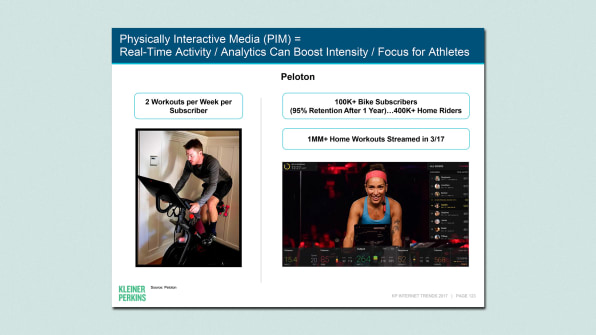Mary Meeker’s annual Internet Trends report shows how apps and interfaces leverage data to exploit our weaknesses.

Ads used to just be ads. They were signs on the side of the road, or in our browsers. They were something that could be ignored. Visually loud, sure, but they weren’t a fundamental part of our conversations, relationships, or entertainment.
But on the internet today, ads aren’t just part of the content or interface, they are the content and the interface. From what photos you see on Facebook, to the music you listen to on Spotify, to the videos you watch on Snapchat–it’s all served by algorithms that have quantified your response well enough to exploit your tastes, showing you things that you will almost certainly click on. By using these apps and services, we’re feeding the companies that control them immense amounts of data that, in turn, tailors the medium to fit our tastes. The difference between an ad and a piece of content, these days, is becoming technical.
It’s an insight that echoes throughout Mary Meeker’s 2017 Internet Trends report, which she and Kleiner Perkins Caufield & Byers published yesterday afternoon. The report, which is heavily anticipated every year, contains hundreds of slides breaking down digital culture and business–everything from emerging markets in China to the rise of unboxing culture. But the trend that stuck out most to us this year? That the internet is now playing every user in one giant game we cannot escape. Here’s how.
FORGET SEARCH TO FIND. TODAY WE SEARCH TO SERVE UP
In the not-so-distant past, Google changed the world by showing us ads related to the things we were searching. Looking for back pain relief? A chiropractor might pay to appear the moment you’re searching, to be the solution. Meeker dubs that old method “search to find.” It’s an active experience on the user’s end, since they already know what they’re looking for.
Now, we’re seeing what happens when suggestive algorithms are in the mix. On Spotify, the app urges us to expand our repertoire, serving up artists that we wouldn’t normally hear–including new releases by pop stars and more. On Netflix, our feeds are customized to be full of the content that we’re most likely to click on.
Meeker dubs this “search to serve up.” When we open these apps, the question in the case of music or movies is often very vague–what should we listen to or watch?–the sort of thing Google’s search box couldn’t answer very well. But search to serve up gives us a very specific answer, tailored to our tastes. And that answer is pure multimedia content.
THE NUDGING INTERFACE

Spotify and Netflix make algorithmic recommendations of their own streaming content–but what happens when e-commerce gets involved? Algorithms meet UI in what becomes a direct revenue stream.Meeker details Instacart as an excellent example. A relatively stupid “Buy It Again” button makes users eight times more likely to repurchase something, but algorithms can take these UI interventions even further. When a shopper finds that a store doesn’t have a go-to, like a certain kind of nut butter, it will algorithmically suggest alternatives and make them appear in the UI, served up in a manner not so different from a Netflix show. Eighty-five percent of item replacements, like this nut butter example, are suggested by algorithm. That means the computer is essentially making the decision for the person–we’re just clicking the buy button.
THE CONTENT IS THE STORE
Of course, in a store, you expect that every item is for sale. Now, the store is leaving the strip mall and showing up in your Facebook feed or Snapchat stories. Here, the content is the ad, and the ad is the store.
We’ve seen this trend evolving for a few years now in Facebook’s carousel ads, which feature multiple photos of one product, or link us to apps we might want to buy. But it’s getting even more intimate, infused with actionable UI to spend money. Instagram now has “tap to book” options on services like salons. Snap used its swipe up function on an X-Men ad to take someone straight to a Fandango store to buy tickets to that movie.
Combine this idea with all that perfectly served algorithmic content, and everything we see becomes an irresistible storefront, the latest impulse buy waiting to happen.
DIGITAL LIFE IS ONE BIG VIDEO GAME, AND WE’RE ALL GAMING OURSELVES

In a somewhat philosophical turn, Meeker shows dozens of slides breaking down a slow evolution of society as game and citizen as gamer, charting progress from Atari game badges to Facebook’s reactions. And frankly, we’ve heard a lot of this before–the played-out term just a few years ago was “gamification.”Meeker points out that it’s not just that the internet has been gamified into one big store that we can’t help but click on, but that we’re actually obsessed with our own identities as players in this gaming environment. We dig into our own data–whether it’s a person who exercises on a Peloton bike, someone who plays the competitive e-sport Overwatch on their PC, or a professional soccer player who logs their off hours in the Fifa video game. We all want the quantification served by analytics software to better our performance.

To some, big data was an overhyped promise. But Meeker seems to be saying something quite different: Our world online, from the advertisers who use it to serve us the perfectly algorithmically coordinated content to the gamer who just wants to beat his best friend’s team the next time they play an e-sport together, is already being shaped and tailored by big data. By 2025, we’ll be creating an estimated eight times the data we do today. And society at large will be ready and willing to use it.
–
